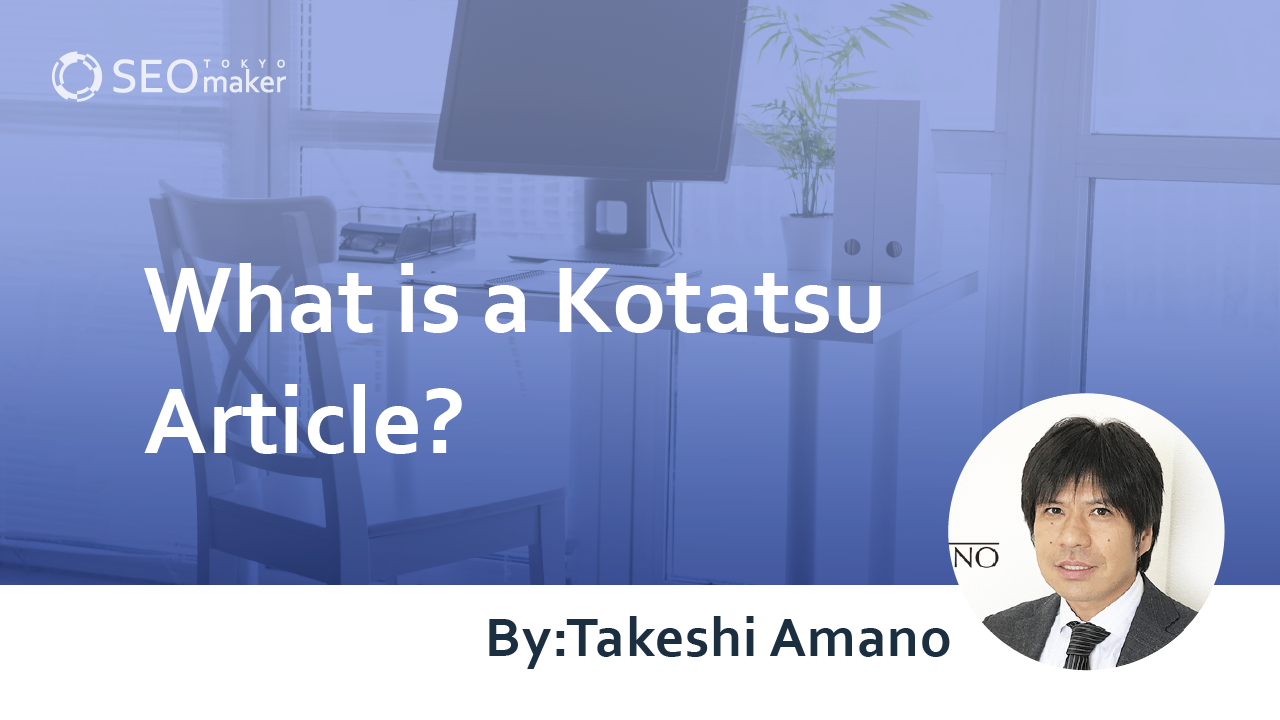What is a Kotatsu Article? : Explaining the Increase and Issues
contents

A kotatsu article is an article written without direct reporting, relying solely on secondary information from the internet, TV, and other media. These articles are common on web media due to their low production cost and the ability to publish them in large quantities, leading to potential revenue. However, relying only on secondary information is not without its issues.
In this article, SEO consultants will explain the reasons for the increase in kotatsu articles, their problems, and the differences between kotatsu articles, SEO articles, and SEO writing.
What is a Kotatsu Article?
A kotatsu article is written without gathering primary information through interviews or other means, relying solely on secondary information from TV, social media, and the internet. The term implies that such articles are written comfortably while sitting under a kotatsu (a Japanese heated table).
The term was coined by an IT professional in 2010 to refer to articles written without any direct reporting. In other words, these articles are written based on media information, books, and other literature.
As the term “kotatsu article” suggests, it often carries a negative connotation, implying that the article was written leisurely in a warm room. Recently, many kotatsu articles are published in web media because they can be produced quickly and cheaply, offering significant benefits to those managing web content.
Although kotatsu articles often do not match the quality of reported articles, they typically maintain a certain level of quality, making it difficult for readers to distinguish between kotatsu articles and reported articles.
Background of the Increase in Kotatsu Articles
Kotatsu articles have increased because they offer many benefits not only to writers but also to those managing web content.
Fewer Steps to Complete an Article
Kotatsu articles have fewer steps to complete, allowing for faster updates of web content.
- Fewer steps to complete an article
- Ability to work without a specific location
- Reduction in production costs
- By mass-producing articles, it is easier to increase page views.
The process to complete an article is minimal
Kotatsu articles can be completed with fewer steps, allowing for the speedy updating of web content.
For a researched article, the process includes the following steps.
1.Negotiating interviews
2.Scheduling
3.Confirming questions
4.Conducting interviews
5.Verifying article content
Unlike kotatsu articles, these tasks involve interacting with people, which imposes time and location constraints. Consequently, researched articles often take longer to complete than kotatsu articles, which can be done independently.
Additionally, researched articles require preparing questions and verifying the content with the interviewee after the article is completed, adding more steps not needed for kotatsu articles.
Kotatsu articles can be started after conducting research using the internet or media, significantly reducing the steps compared to researched articles. For web content managers who want to quickly produce many articles, kotatsu articles are often the preferred choice.
Work Can Be Done Anywhere
When writing kotatsu articles, the entire article creation process can be completed from home. This allows you to work anytime and anywhere without the need for a specific workspace.
Being able to write articles at your convenience supports a work-life balance that suits many people’s lifestyles.
Compared to writing articles that require interviews, kotatsu articles offer more flexibility. Therefore, individuals who freelance as writers often prefer to write kotatsu articles over interview-based articles.
Reduced Production Costs
Commissioning kotatsu articles can lead to significant cost reductions for web content operators. When assigning interview-based articles to writers, a greater number of steps are required, which typically results in higher fees for the manuscript. Furthermore, additional costs incurred during the interview process mean that producing just one article can be quite costly.
In the case of kotatsu articles, only the costs related to compensating the writer for creating the article are incurred, with almost no additional expenses. Moreover, if the writers are of high quality, it’s possible to mass-produce articles that maintain a certain level of quality.
The lower the costs to complete the manuscript, the greater the benefits for the operators. While it may seem that the advantages of kotatsu articles are concentrated on the side of the writers, there are substantial benefits for the operators as well, which is why the trend of publishing kotatsu articles is on the rise.
Increasing Page Views by Mass-Producing Articles
By commissioning kotatsu article writers, you can mass-produce articles. Consequently, in managing owned media, increasing the amount of web content leads to a higher number of page views (PVs), thus boosting revenue.
It is believed that mass-producing articles with a certain level of quality yields better SEO results and leads to higher revenue compared to meticulously crafting a single well-researched article.
When the term “kotatsu article” was coined in 2010, Google search results only displayed the title and a brief description. Back then, even low-quality kotatsu articles could attract high PVs and generate revenue if they had compelling titles and descriptions. However, today, kotatsu articles with thin content, high similarity, or high copy rates do not perform well in SEO, leading to an increase in the quality of kotatsu articles.
Currently, web content managers believe that publishing high-quality, mass-produced kotatsu articles yields better revenue growth than publishing meticulously crafted, well-researched articles, leading to the prevalence of kotatsu articles.
Issues with Kotatsu Articles
Although kotatsu articles offer advantages for both writers and commissioners, there are several drawbacks. The specific issues are as follows.
- Low-quality articles
- Lack of originality
- Increased number of similar articles negatively affecting search users
Low-Quality Articles
A major problem with kotatsu articles is the decline in quality.
Kotatsu articles often utilize secondary information, leading to lower content quality compared to researched articles. They may contain incorrect information or lack depth, which is a significant issue from the user’s perspective.
If publishing as a web medium, the content must be beneficial to users. Producing a large number of incorrect or shallow articles should be avoided.
While high-quality kotatsu articles are acceptable, it is challenging for typical kotatsu article writers to produce articles of higher quality than well-researched ones.
To avoid mass-producing low-quality articles, it is also crucial for those commissioning kotatsu articles to ensure a certain quality standard. Providing users with valuable information is essential.
Lack of Originality
Kotatsu articles often lack originality, as they typically compile and skillfully combine secondary information.
Images or photos used in the articles are often sourced from other content, and the article structure or expression methods may resemble those of other articles.
Mass-producing kotatsu articles can result in many similar contents appearing in search results, which is not beneficial from a search user’s perspective.
From an SEO standpoint, articles lacking originality or containing copied content are rated poorly by Google’s algorithms and tend not to rank highly. Although the prevalence of low-quality, unoriginal articles in search results has decreased, it has not been eliminated.
Harmful Effects of Similar Articles on Search Users
When kotatsu articles are mass-produced, high-quality, carefully crafted articles can get buried in search results, requiring users to sift through the information. Although not all kotatsu articles are of low quality, they often do not meet the standards of well-researched articles. Additionally, kotatsu articles can sometimes rank higher than reported articles, forcing users to judge the quality of the articles themselves.
It is possible for search results to be dominated by similar articles from the first to the tenth positions. This occurs when competing articles include the same essential elements needed for the search keyword, leading to numerous similar articles appearing in search results.
For search users, both kotatsu and reported articles are part of the same media. Therefore, mass-producing low-quality kotatsu articles can degrade the overall reputation of the media and the web industry. Consequently, search users need to reference multiple web media sources for specific keywords, which is not an ideal situation.
Commissioning Kotatsu Article Writers
Here is how you can commission kotatsu article writers, considering how they work. This can be useful if you want to mass-produce web content or reduce costs.
Process for Kotatsu Article Writers to Deliver Articles
Here is the typical process from when kotatsu article writers accept an assignment to when they deliver the article.
- Apply for writing jobs on platforms like CrowdWorks, job sites, or company websites.
- Discuss the specific details and deadlines of the assignment via email or chat.
- Write the article according to the discussed details.
- Submit the completed article via email or chat.
- Make revisions if requested; otherwise, complete the delivery.
This entire process can be completed online, allowing for speedy article creation by both the writer and the client. Depending on the article’s content, the deadline is usually one to two weeks.
How to Commission Kotatsu Article Writers
Most kotatsu article writers apply for writing assignments posted on crowdsourcing platforms, job sites, or company websites. Therefore, to recruit writers, you need to post job requirements and assignment details on these platforms.
Communication with writers typically occurs through emails on the crowdsourcing platform or other email/chat apps.
Since the writing levels of applicants vary, it’s important to review their writing experience and portfolios if you require a certain quality level.
Budget for Commissioning Kotatsu Article Writers
The cost of commissioning kotatsu article writers varies based on the writer and the content. When using crowdsourcing platforms or direct assignments, the cost is often based on the price per character.
For example, at a rate of 1 yen per character, a 1,000-character article would cost 1,000 yen. The price per character can range widely, from as low as 0.1 yen to over 2 yen, depending on the writer’s experience and qualifications.
To hire writers who can produce high-quality articles, you may need to set a higher price per character when posting your job.
Differences Between Kotatsu Articles and SEO Articles
Kotatsu articles and SEO articles share some common elements, so they are not entirely different. SEO articles aim to rank high in search results, and kotatsu articles can also aim for high SEO rankings.
However, kotatsu articles often lack the most crucial element for achieving high search rankings: providing valuable information to search users. Therefore, some see them as different from SEO articles.
Although kotatsu articles often use secondary information and tend to be lower quality compared to researched articles, they can still provide useful information to search users as SEO articles.
Kotatsu article writers and those commissioning the articles often create them with the SEO goal of mass-producing articles of a certain quality. If the articles aim to rank high in SEO, then kotatsu articles can be considered SEO articles.
If we consider kotatsu articles as SEO articles, it’s important for kotatsu article writers to learn SEO writing to achieve high search rankings and not compromise on providing valuable information to search users.
Summary
The issue with kotatsu articles is the risk of mass-producing low-quality articles that are not useful to search users. Therefore, as long as quality is maintained, it does not matter whether the article is a kotatsu article or a researched article. Kotatsu article writers and web content managers should focus on publishing high-quality articles and continuously providing valuable information to users. This approach will lead to high SEO ratings and attract more traffic to the web content.










![What is a Description? Explaining the Meaning, Writing Style, and Changing Word Count – [2023 Edition]](https://www.switchitmaker2.com/en/wp-content/uploads/2024/09/what-is-description.webp)










